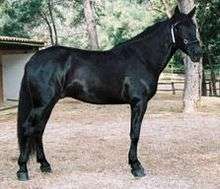Mallorquín
 A Mallorquín horse | |
| Alternative names | Cavall Mallorquí, Mallorquina |
|---|---|
| Country of origin | Mallorca, Spain |
| Breed standards | |
| Dirección General de Recursos Agrícolas y Ganaderos | Breed standards |
| Equus ferus caballus | |
The Mallorquín or Caballo Mallorquín (Catalan: Cavall Mallorquí) is a rare breed of horse indigenous to the island of Majorca in the Balearic Islands, from which it takes its name. Identification of the breed was begun in 1985 by the Patronato para las Razas Autóctonas de Mallorca ("authority for the autochthonous breeds of Mallorca"). The Mallorquín is listed in the Catálogo Oficial de Razas de Ganado de España in the group of autochthonous breeds in danger of extinction.[1] Its status was listed in 2007 as critical by the Food and Agriculture Organization of the United Nations.[2] In approximately 2005 the number of Mallorquín horses recorded in the stud-book was 247, but a census conducted by the Ministerio de Medio Ambiente y Medio Rural y Marino in 2003 identified only 172.[3]
In some English-language publications, the Mallorquín and Menorquín are not listed, but horses of the Balearic Islands are merged into a grouping called the "Balearic horse" or "Balearic pony."[4][5][6][7] However, authoritative sources, including the Government of the Balearic Islands,[8] the Ministerio de Medio Ambiente y Medio Rural y Marino of Spain[9] and the Food and Agriculture Organization of the United Nations,[10] make it clear that they are two separate breeds.
Characteristics
The Mallorquín may only be black, in all its variations; horses of any other colour can not be registered. Limited white facial markings are permitted, white leg markings are not. The minimum permissible height 1.52 m (15.0 hands) for males and 1.48 m (14.2 hands) for females.[11] It has an upright mane, short, thick, but arched neck, a head with a convex profile but refined bone structure.
History
The origins of the breed are obscure. According to a genetic study of "Spanish Celtic horse breeds", the Mallorquín and Menorquín are connected to the now extinct Catalan horse,[12] itself the result of introgression of populations with strong African genetic influence into an original population of Celtic horses introduced to the Iberian peninsula by the Celts in about the 8th century BC.[13] The study showed clear grouping of the two Mediterranean breeds and clear separation from the five "Atlantic" Celtic breeds examined, the Asturcón, Gallego, Jaca Navarra, Losino and Pottok.[14]
Uses
This breed is used by the local population only as a riding horse; farm work in the islands was traditionally done by the Balearic donkey.[15] Mallorquín mares were traditionally bred to imported stallions, usually of French Trotter or Orlov Trotter breed, to produce Trotador Español, "Spanish Trotter", horses. Approximately 85% of the Spanish Trotter population is in Mallorca; however, genetic study has found little recent influence of the Mallorquín on the Spanish Trotter breed.[3]
See also
References
- ↑ "Ganaderia: Clasificación de Razas". Ministerio de Medio Ambiente y Medio Rural y Marino. (in Spanish). Archived from the original on January 16, 2011. Retrieved Apr 2011. Check date values in:
|access-date=(help) - ↑ "Critical Breeds List 2007" (PDF). FAO. Retrieved Apr 2011. Check date values in:
|access-date=(help) - 1 2 Azor P.J.; Valera M.; Gómez M.D.; Goyache F.; Molina A. (2007). "Genetic characterization of the Spanish Trotterhorse breed using microsatellite markers". Genetics and Molecular Biology. 30: 37–42. doi:10.1590/s1415-47572007000100009.
- ↑ Lydekker, Richard. The horse and its relatives - Page 137-138
- ↑ Bauer, Mary Ellen. Which Horse of Course p. 61
- ↑ Sliver, Caroline. Guide to the Horses of the World, Chartwell Books, 1991 and Illustrated Guide to Horses of the World, Longmeadow Press, 1993 appear to be the same book, p. 102
- ↑ Nendricks, Bonnie L and Anthony A. Dent. International Encyclopedia of Horse Breeds, p. 60
- ↑ "Razas Autóctonas de las Illes Balears" (in Spanish). Govern de las Illes Balears. Retrieved July 2011.
Autochthonous breeds of the Balearic Islands
Check date values in:|access-date=(help) - ↑ "Raza Autóctona en Peligro de Extinción" (in Spanish). Ministerio de Medio Ambiente y Medio Rural y Marino. Retrieved July 2011.
Autochthonous breed in danger of extinction
Check date values in:|access-date=(help) - ↑ "Farm Animal Genetic Resources" (PDF). Food and Agriculture Organization of the United Nations. Retrieved Apr 2011. Check date values in:
|access-date=(help) - ↑ "Orden del Consejero de Agricultura y Pesca de, 12 de junio de 2003, por la que se establecen las normas zootecnicas del caballo de Pura Raza Mallorquina" (PDF). Ministerio de Medio Ambiente y Medio Rural y Marino. Retrieved July 2011.
Order of the Counsellor for Agriculture and Fisheries, 12 June 2003, for the establishment of breeding standards for the horse of pure Mallorqín breed
Check date values in:|access-date=(help) - ↑ Martinez J.M., M. Valera & A. Molina (1996) 'El caballo Losino' Animal Genetic Resources Information 19, 17–27. Cited by Cañon, not consulted.
- ↑ Aran, S. (1949) Caballos, mulos, asnos Madrid: Gráficas Yagües. Cited by Cañon, not consulted.
- ↑ Cañon J, Checa ML, Carleos C, Vega-Pla JL, Vallejo M, Dunner S (February 2000). "The genetic structure of Spanish Celtic horse breeds inferred from microsatellite data". Anim. Genet. 31 (1): 39–48. doi:10.1046/j.1365-2052.2000.00591.x. PMID 10690360.
- ↑ "Traditions and fiestas". Retrieved July 2011. Check date values in:
|access-date=(help)
.jpg)